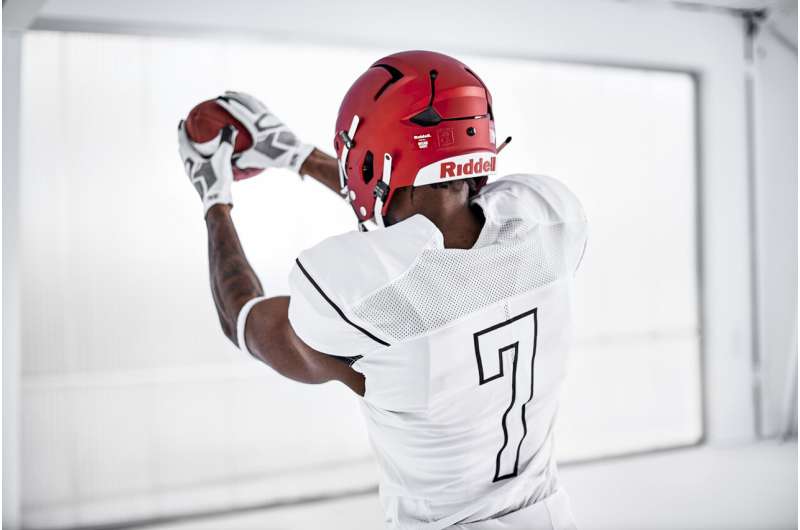Riddell’s Axiom could be breakthrough helmet for football
Riddell has developed a football helmet that might not be just the next big step in design and player safety, but a major leap.
While there has been a focus on position-specific headgear for sometime, Axiom is a personal-fit helmet. It is designed and manufactured player by player rather than position by position.
Axiom’s features are based on data and designed to improve impact response, reduce head impact exposure (HIE), and deliver unprecedented protection. Axiom includes a new fitting system, a redesigned helmet shell platform, reimagined face-mask system and integrated smart helmet technology called InSite—which analyzes and reports on HIE compared to Riddell’s database of 8 million on-field player impacts.
Axiom also features a removable visor.
“We don’t want to call it a crowning achievement, we get up every day and try to improve player protection,” says Thad Ide, senior vice president of research and development for Riddell. “But we do feel Axiom is a very different helmet platform than we have seen before, and potentially a great leap forward.”
There are several key elements to Axiom that could make it the safest head protection football—and pretty much any sport—has seen.
The fitting system uses technology that scans the surface of a player’s head to build a helmet that matches the fit of the head. The scans can be done on a phone app by a coach or equipment manager or a player—by anyone, really. The data are loaded into Riddell’s database and then a built-to-fit helmet for the individual athlete is made.
Shells of the Axiom are engineered to surround the head with a combination of flex panels that work in tandem with internal liners and a face protection system to improve impact response.
As for the new facemask, it removes the top bar to provide additional flexing, more energy-managing material and a better impact response. A cast construction available in both stainless steel and titanium and a unique elliptical shape will provide and a sweeping view of the field for each player.
“We don’t know how long it will take for players to get used to seeing the field better,” Ide explains, “but there is also a lot of design freedom with the face guards. Anything you can mold you can turn the face guard into.”
Among the more intriguing aspects of the Axiom is the visor, something popular with running backs, receivers and defensive backs—about 600 players wear them—but not a lot of other positions. Yet.

This is the first football helmet to offer a standard factory-installed visor.
“There’s a two-push button to remove the visor, however it is part of the protective suite within the helmet,” Ide says. “Feedback has been good but it is different, and there are some players who simply aren’t going to wear a visor, which is why we made it easy to remove.
“We’ve collected feedback from field test participants, elite college athletes who were wearing them, and more were leaving them on.
“The feedback we have gotten is Axiom fits like a precision-fit helmet,” Ide add, “that it tracks exactly with the players’ heads. There’s no helmet lag if you turn quickly.”
Versions of Axiom have been tested for use the past three seasons at select colleges and high schools. Florida State, Penn State, UCLA, Rice, Stanford, Oregon State, Bowling Green, Colorado and SMU are among the FBS schools to have players wear them.
“Customization is the future of helmets,” says Jeff Miller, the NFL’s the league’s executive vice president of communications, public affairs and policy. “This season we saw promising developments with the first position-specific helmet on-field and the increasing use of 3D scanning and printing for helmets worn by NFL players. Each position has unique safety characteristics. Through innovation, which the NFL continues to drive through our funding competitions, annual helmet testing and sharing our data with manufacturers and entrepreneurs, players will continue to enjoy more and better choices that evolve alongside the technology.”
Axiom costs around $750 for NFL and elite college players—the pricing structure has not been finalized—and includes the titanium face guard and certain other accessories. It will go to market this winter, with a limited number on the field in the spring for college practices. High schools, small colleges and other varsity-playing football institutions will have access later in the spring.
Ide also expects it will be on the NFL evaluation posters when they are published in the spring.
As for expanding to other sports, Ide notes there are elements of Axiom that could apply to lacrosse and ice hockey.
“Other sports have different needs than football, from the protective and vision side,” he notes. “For most the fit system and scanning of the head could extend into other sports, and the smart technology as well.
“We are focused on football right now. This sort of technology needs to take hold in football before extending to other sports.”
VICIS has top 3 helmets in survey including lineman model
© 2022 The Associated Press. All rights reserved. This material may not be published, broadcast, rewritten or redistributed without permission.
Citation:
Riddell’s Axiom could be breakthrough helmet for football (2022, January 5)
retrieved 5 January 2022
from https://techxplore.com/news/2022-01-riddell-axiom-breakthrough-helmet-football.html
This document is subject to copyright. Apart from any fair dealing for the purpose of private study or research, no
part may be reproduced without the written permission. The content is provided for information purposes only.
For all the latest Technology News Click Here
For the latest news and updates, follow us on Google News.
